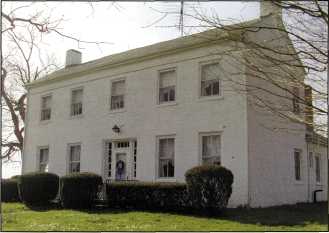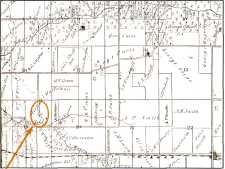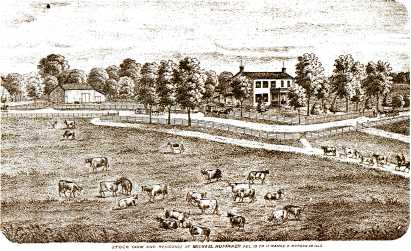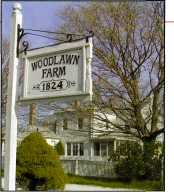F r e e d o m f a r m
Runaway slaves found hope and opportunity on Michael Huffaker's Morgan County homestead

Woodlawn Farm was established in 1824. It is a documented station on the Underground Railroad.
|
By Greg Olson
Little Fannie Huffaker was awakened by a commotion in the downstairs hallway. She could hear a baby crying; she had to investigate.
"She jumped out of bed, crept to the head of the old walnut stairs

The Huffaker farm as it appeared on the 1872 Atlas Map of Morgan County.
|
and, clinging to the banisters, looked down into the hall," wrote her daughter, Fannie Crassly, years later. "There were a colored man and two white ones whispering together and a mulatto woman with a little child in her arms. The woman's eyes rolled with fright, and she tried to hush the child's cries. Then she saw a neighbor, Hess Craig, open a door and hustle the strangers into a room.
"The colored people were in a pitiful state, bedraggled and only half clothed. Mother thought they must be some new help, and, thinking she would see them in the morning, she went back to bed." Miss Huffaker looked for them the next day, but she could not find them. The strangers at the Huffaker farm that night were fugitive slaves, and Miss Huffaker promised her mother she would never tell of their stopover at the family farm.
The Huffaker farm, located a few miles east of Jacksonville and bordered on the south by the middle fork of Mauvaisterre Creek, was a haven for runaway slaves fleeing their Southern masters for freedom in the North. Fannie Huffaker's parents were Michael and Jane Huffaker. Mr. Huffaker, a native of Kentucky, bought land east of Jacksonville in the early 1820s, paying $1.25 an acre, according to the 1872 Atlas Map of Morgan County.
Mrs. Huffaker, who was related to President James Monroe, was Mr. Huffaker's second wife. Together, they operated one of many clandestine stations on the famous Underground Railroad, a network of households that helped runaway slaves escape to permanent freedom. It was established by abolitionists, particularly free blacks in the North.
"Mr. Huffaker was a valuable man (on the Underground Railroad) because he was fearless, won everyone's respect, and never talked," Morgan County historian Ensley Moore once said. "Michael, having been accustomed to Negro labor in Kentucky and needing good farmhands, built cabins on his farm and established colored families in them, the men doing outside work and the women helping in the house when needed," wrote Miss Grassly, one of Mr. Huffaker's grandchildren. The fugitive slaves helped Huffaker run his extensive grain, cattle, and horse farm, which he named "Woodlawn Farm."
"Michael's farm was one of the safest stations on the route from Jacksonville to Springfield, due to the Negro cabins and the fact that it was well known that he employed mostly Negro help," wrote Miss Grassly.
"Besides, if bloodhounds were being used, the refugees, once
ILLINOIS HERITAGE| 17

The 1872 Atlas Map of Morgan County features this sketch of Michael and Jane Huffaker's Woodlawn Farm, where runaway slaves found food and shelter before the Civil War.
|
reaching Jacksonville, would be taken to the brook, sometimes through the famous tunnels in the town, follow the brook to the Mauvaisterre, leave the creek where it branched into Michael's farm and there, sheltered by the orchard, reach the house or one of the cabins safely. If the danger was too great, they were rushed on to the next station."
The house was bought in December 2003 by the Morgan County Historical Society, which has plans to turn the Huffakers Woodlawn Farm into a living history museum highlighting the family's involvement with the Underground Railroad.
Greg Olson of Jacksonville writes a history column for the Journal-Courier news-paper. He served as the assistant director of the Illinois State Historical Society from 1994 to 1999.
18 |ILLINOIS HERITAGE
H o u s e o f d r e a m s
By Greg Olson
Art Wilson is living his dream. Residing in a 164-year-old house, the Jacksonville historian is surrounded by the past, especially one aspect that intrigues him the most.
Over the last ten years, Wilson has become well-versed in the local story of the Underground Railroad, and his current residence played a role in that drama.
Last January, Wilson moved into the old brick house on Woodlawn Farm, located about four miles due east of Jacksonville and a short distance south of I-72. The farm was established in 1824 by Michael Huffaker, one of Morgan County's earliest settlers. According to Huffaker family history, the grain and cattle farm also served as a station on the Underground Railroad, a secretive network of safe houses that helped runaway slaves from the South gain their freedom in the North. For Wilson, the Huffaker farm is a tangible reminder of an important part of black Americans' past.
"For me, it's definitely a dream come true," Wilson said. "It's an opportunity for me to live within the history that I enjoy researching. My dream is to have Woodlawn Farm become the gateway to introducing people to the local history of the Underground Railroad as well as to other facets of Jacksonville and Morgan County history." Wilson, a member of the Underground Railroad Committee of the Morgan County Historical Society, serves as caretaker of Woodlawn Farm, which the Historical Society bought late last year.
The purchase price included the eight-room house, several outbuildings, and six acres. The sellers, Leon "Bud" and Trudy Gierke, gave the Historical Society an additional four acres and a cash contribution. Wilson first met the Gierkes in 1999, after he stumbled across a history of the Huffaker family while doing research on the Underground Railroad at the Jacksonville Public Library. "I didn't know that the Huffakers had any connection to the Underground Railroad," Wilson said, "I was just reading biographies and luckily came across Michael Huffaker's."
The biography steered him to the Morgan County Courthouse in search of more clues. There, employees of the county clerk's office helped him locate the old Huffaker farm, then owned by the Gierkes. Wilson telephoned Mr. Gierke, who gave him more details about the Pluffaker family and the location of cabins used by former slaves on the farm. When meeting the Gierkes, Wilson recalled: "I teased them. . . about the possibility that if they ever decided to sell the house, I would be interested in buying it." But the Gierkes weren't selling the place they had called home for about 50 years.
Not long after visiting Woodlawn Farm, Wilson had photographs taken of the house and used them in slide shows he presented on the history of the Underground Railroad in the Jacksonville area. And then last summer, Wilson helped form an Underground Railroad Committee to try to buy the Porter Clay House at 1019 W. State Street in Jacksonville.
The Clay Flouse was built in about 1836 by Mr. Clay, a brother of famous U.S. Senator Henry Clay of Kentucky. Porter Clay's wife, Elizabeth, owned slaves who were kept for a time at the West State Street house. "I was interested in that house not only because slaves were kept there, but because of all of the people connected with the history of the house, its architectural importance and the fact that it was for sale," Wilson said. "The Porter Clay House, though, was not a station on the Underground Railroad. In fact, it was the exact opposite. I include it on Underground Railroad tours to show both sides of the slave story."
Nevertheless, Wilson said the
 Underground Railroad Committee was interested in buying the Clay House until the Huffaker farm went on the market. The Huffaker farm "better meets the goals of the Underground Railroad Committee," he said. The goals of the committee are ambitious. "We want to make the house and grounds into a living history museum where re-enactors will portray members of the Huffaker family, their black farm laborers, and the fugitive slaves harbored by Mr. Huffaker," Mr. Wilson said. "We also will focus on the agricultural aspects of life on an Illinois farmstead in the antebellum period, complete with farm animals."
Underground Railroad Committee was interested in buying the Clay House until the Huffaker farm went on the market. The Huffaker farm "better meets the goals of the Underground Railroad Committee," he said. The goals of the committee are ambitious. "We want to make the house and grounds into a living history museum where re-enactors will portray members of the Huffaker family, their black farm laborers, and the fugitive slaves harbored by Mr. Huffaker," Mr. Wilson said. "We also will focus on the agricultural aspects of life on an Illinois farmstead in the antebellum period, complete with farm animals."
The Illinois Department of Transportation has expressed interest in helping the committee by improving access and providing signs to the farm, according to Wilson. "They also said they could help us plant native grasses on the farm," he added. In addition, plans are being made to strengthen a bridge over the middle fork of Mauvaisterre Creek, just south of the farm. Other long-range committee goals are to reconstruct a wooden fence and the cabins of the black laborers on the farm. Wilson credits the committee for pulling together to make this potential living history museum a reality.
"In the same way it took many people to establish an Underground Railroad system in the early 1800s, it took that same commitment by a group of people to establish our local Underground Railroad Committee," he said.
|
ILLINOIS HERITAGE| 19
|

